Revelation of Coupled Ecosystem Quality and Landscape Patterns for Agroforestry Ecosystem Services Sustainability Improvement in the Karst Desertification Control
Abstract
:1. Introduction
2. Methods
2.1. Protocol
- What are the trends in the number of publications over the years, the types of research topics that can be classified, and the number of each topic?
- What are Global ELA research focus regions and their institutional distribution?
- What are the current major research progress and landmark results?
- What are the key scientific questions that need to be addressed in future research?
- What are the implications of this study in terms of enhancing the sustainability of agroforestry benefits in the KRD region?
2.2. Literature Search Sources
2.3. Literature Selection Criteria
- First, all the literature was screened for duplicate items and 689 relevant papers were obtained.
- Second, the literature was examined according to study title, abstract, and keywords, and studies with low relevance to the research topic were eliminated. For example, although the title “Landscape Composition Is More Important than Local Vegetation Structure for Understory Birds in Cocoa Agroforestry Systems” mentions key terms such as agroforestry ecosystems and landscape composition, the abstract states that the focus of the study is on the role of birds, and therefore, was excluded.
- Third, the literature retained from the secondary screening was read in its entirety, and the screening was based on covering at least one ELA-related study for eligibility determination. For example, a full reading of “Conserving Biodiversity Through Certification of Tropical Agroforestry Crops at Local and Landscape Scales” revealed that the study focused on the certification experience of tropical agroforestry crops (coffee and cocoa) and proposed certification at the landscape scale. Therefore, it was eliminated.
- Ultimately, 163 articles that were highly relevant to the research topic after three rounds of screening were included in the process to form the final sample for this study.
2.4. Synthesis Report
3. Results and Analysis
3.1. Annual Distribution and Research Contents of the Literature
3.2. Research Region and Institution Distribution
4. Retrospect and Prospects
4.1. Research Progress and Landmark Results
4.1.1. Ecosystem Quality
4.1.2. Landscape Pattern
4.1.3. Benefit Coupling Mechanism
4.1.4. Landscape Optimization Design
4.2. Key Scientific Questions
4.2.1. Clarify Key Factors Affecting Ecosystem Quality Change, with a Focus on Getting Away from Habitat-Specific Studies
4.2.2. To Solve the Current “Barrel Effect”, It Is Urgent to Clarify the Relationship between Landscape Pattern and Ecological Process in the Special Artificial Ecosystem of Agroforestry
4.2.3. Scientifically Assess the Effect of Landscape Heterogeneity on Agroforestry Ecosystems, Focusing on Multiscale Comprehensive Analysis Combined with Scenario Simulation Techniques
4.2.4. Promoting Agroforestry Landscape Optimization Practices Needs to Pay Attention to the Challenges of Spatial and Temporal Dynamics, and the Key Lies in Conceptual Guidance and Promoting a Change in Thinking
4.2.5. Continued Improvement of Service Supply Capacity Urgently Requires Attention to Future Climate Change and the Establishment of a Systematic Assessment System Combined with Resilience Theory
4.3. Revelation on Enhancing the Sustainability of Agroforestry Benefits in KRD Control Areas
4.4. Limitations of the Study
5. Conclusions
Author Contributions
Funding
Institutional Review Board Statement
Data Availability Statement
Conflicts of Interest
References
- MEA (Millennium Ecosystem Assessment). Ecosystems and HumanWell-being: Synthesis; Island Press: Washington, DC, USA, 2005. [Google Scholar]
- McAdam, J.H.; Burgess, P.J.; Graves, A.R.; Rigueiro-Rodríguez, A.; Mosquera-Losada, M. Classififications and functions of agroforestry systems in Europe. In Agroforestry in Europe; Rigueiro-Rodríguez, A., McAdam, J., Mosquera-Losada, M., Eds.; Springer: Amsterdam, The Netherlands, 2009; pp. 21–41. [Google Scholar] [CrossRef]
- Nair, P.K.R. Classification of agroforestry systems. Agrofor. Syst. 1985, 3, 97–128. [Google Scholar] [CrossRef]
- Mosquera-Losada, M.; McAdam, J.H.; Romero-Franco, R.; Santiago-Freijanes, J.; Rigueiro-Rodríguez, A. Defifinitions and components of agroforestry practices in Europe. In Agroforestry in Europe; Rigueiro-Rodríguez, A., McAdam, J., Mosquera-Losada, M., Eds.; Springer: Amsterdam, The Netherlands, 2009; pp. 3–19. [Google Scholar] [CrossRef]
- Nerlich, K.; Graeff-Hönninger, S.; Claupein, W. Agroforestry in Europe: A review of the disappearance of traditional systems and development of modern agroforestry practices, with emphasis on experiences in Germany. Agrofor. Syst. 2013, 87, 475–492. [Google Scholar] [CrossRef]
- Jose, S. Agroforestry for ecosystem services and environmental benefits: An overview. Agrofor. Syst. 2009, 76, 1–10. [Google Scholar] [CrossRef]
- Duru, M.; Therond, O.; Martin, G.; Martin-Clouaire, R.; Magne, M.-A.; Justes, E.; Journet, E.-P.; Aubertot, J.-N.; Savary, S.; Bergez, J.-E.; et al. How to implement biodiversity-based agriculture to enhance ecosystem services: A review. Agron. Sustain. Dev. 2015, 35, 1259–1281. [Google Scholar] [CrossRef]
- Dumont, E.S.; Gnahoua, G.M.; Ohouo, L.; Sinclair, F.L.; Vaast, P. Farmers in Côte d’Ivoire value integrating tree diversity in cocoa for the provision of ecosystem services. Agrofor. Syst. 2014, 88, 1047–1066. [Google Scholar] [CrossRef] [Green Version]
- Varah, A.; Jones, H.; Smith, J.; Potts, S.G. Temperate agroforestry systems provide greater pollination service than monoculture. Agric. Ecosyst. Environ. 2020, 301, 107031. [Google Scholar] [CrossRef]
- Su, C.H.; Fu, B.J. The relationship between landscape pattern and ecological processes and its impact on ecosystem services. J. Nat. 2012, 34, 277–283. (In Chinese) [Google Scholar]
- Anderson-Teixeira, K.J.; Davies, S.J.; Bennett, A.C.; Gonzalez-Akre, E.B.; Muller-Landau, H.C.; Wright, S.J.; Abu Salim, K.; Almeyda Zambrano, A.M.; Alonso, A.; Baltzer, J.L.; et al. CTFS-ForestGEO: A worldwide network monitoring forests in an era of global change. Glob. Chang. Biol. 2014, 21, 528–549. [Google Scholar] [CrossRef] [Green Version]
- Homer, C.; Dewitz, J.; Jin, S.; Xian, G.; Costello, C.; Danielson, P.; Gass, L.; Funk, M.; Wickham, J.; Stehman, S.; et al. Conterminous United States land cover change patterns 2001–2016 from the 2016 National Land Cover Database. ISPRS J. Photogramm. Remote Sens. 2020, 162, 184–199. [Google Scholar] [CrossRef]
- Corry, R.C. How measures of agricultural landscape patterns are affected by crop rotation dynamics. Landsc. Ecol. 2019, 34, 2159–2167. [Google Scholar] [CrossRef]
- Pavlidis, G.; Tsihrintzis, V.A. Environmental Benefits and Control of Pollution to Surface Water and Groundwater by Agroforestry Systems: A Review. Water Resour. Manag. 2018, 32, 1–29. [Google Scholar] [CrossRef]
- Vandermeulen, S.; Ramirez-Restrepo, C.A.; Beckers, Y.; Claessens, H.; Bindelle, J. Agroforestry for ruminants: A review of trees and shrubs as fodder in silvopastoral temperate and tropical production systems. Anim. Prod. Sci. 2018, 58, 767–777. [Google Scholar] [CrossRef] [Green Version]
- Jiang, S.; Xiong, K.; Xiao, J. Structure and Stability of Agroforestry Ecosystems: Insights into the Improvement of Service Supply Capacity of Agroforestry Ecosystems under the Karst Rocky Desertification Control. Forests 2022, 13, 878. [Google Scholar] [CrossRef]
- Xiao, J.; Xiong, K. A review of agroforestry ecosystem services and its enlightenment on the ecosystem improvement of rocky desertification control. Sci. Total. Environ. 2022, 852, 158538. [Google Scholar] [CrossRef]
- Wu, Z.; Zhu, D.; Xiong, K.; Wang, X. Dynamics of landscape ecological quality based on benefit evaluation coupled with the rocky desertification control in South China Karst. Ecol. Indic. 2022, 138, 108870. [Google Scholar] [CrossRef]
- Blew, R.D. On the definition of ecosystem. Bull. Ecol. Soc. Am. 1996, 77, 171–173. [Google Scholar] [CrossRef]
- Azarov, A.; Polesny, Z.; Darr, D.; Kulikov, M.; Verner, V.; Sidle, R.C. Classification of Mountain Silvopastoral Farming Systems in Walnut Forests of Kyrgyzstan: Determining Opportunities for Sustainable Livelihoods. Agriculture 2022, 12, 2004. [Google Scholar] [CrossRef]
- Elbakidze, M.; Surová, D.; Muñoz-Rojas, J.; Persson, J.-O.; Dawson, L.; Plieninger, T.; Pinto-Correia, T. Perceived benefits from agroforestry landscapes across North-Eastern Europe: What matters and for whom? Landsc. Urban Plan. 2021, 209, 104044. [Google Scholar] [CrossRef]
- Wen, Z.Z.; Lu, J.J. Applied Ecology; Shanghai Educational Publishing House: Shanghai, China, 2004. (In Chinese) [Google Scholar]
- Schmidt, M.H.; Roschewitz, I.; Thies, C.; Tscharntke, T. Differential effects of landscape and management on diversity and density of ground-dwelling farmland spiders. J. Appl. Ecol. 2005, 42, 281–287. [Google Scholar] [CrossRef]
- Thies, C.; Steffan-Dewenter, I.; Tscharntke, T. Interannual landscape changes influence plant–herbivore–parasitoid interactions. Agric. Ecosyst. Environ. 2008, 125, 266–268. [Google Scholar] [CrossRef]
- Canedoli, C.; Manenti, R.; Padoa-Schioppa, E. Birds biodiversity in urban and periurban forests: Environmental determinants at local and landscape scales. Urban Ecosyst. 2018, 21, 779–793. [Google Scholar] [CrossRef]
- Thiele, J.; Schirmel, J.; Buchholz, S. Effectiveness of corridors varies among phytosociological plant groups and dispersal syndromes. PLoS ONE 2018, 13, e0199980. [Google Scholar] [CrossRef] [PubMed] [Green Version]
- Duflot, R.; Daniel, H.; Aviron, S.; Alignier, A.; Beaujouan, V.; Burel, F.; Cochard, A.; Ernoult, A.; Pain, G.; Pithon, J.A. Adjacent woodlands rather than habitat connectivity influence grassland plant, carabid and bird assemblages in farmland landscapes. Biodivers. Conserv. 2018, 27, 1925–1942. [Google Scholar] [CrossRef]
- Winfree, R.; Kremen, C. Are ecosystem services stabilized by differences among species? A test using crop pollination. Proc. R. Soc. B 2009, 276, 229–237. [Google Scholar] [CrossRef] [PubMed] [Green Version]
- Jeanneret, P.; Aviron, S.; Alignier, A.; Lavigne, C.; Helfenstein, J.; Herzog, F.; Kay, S.; Petit, S. Agroecology landscapes. Landsc. Ecol. 2021, 36, 2235–2257. [Google Scholar] [CrossRef]
- Ndao, B.; Leroux, L.; Gaetano, R.; Diouf, A.A.; Soti, V.; Bégué, A.; Mbow, C.; Sambou, B. Landscape heterogeneity analysis using geospatial techniques and a priori knowledge in Sahelian agroforestry systems of Senegal. Ecol. Indic. 2021, 125, 107481. [Google Scholar] [CrossRef]
- Saint-Laurent, D.; Berthelot, J.-S.; Gervais-Beaulac, V. Habitat fragmentation and structure and composition of tree populations in a agroforestry landscape (southern Québec, Canada). Agrofor. Syst. 2017, 92, 1517–1534. [Google Scholar] [CrossRef]
- Taylor, P.D.; Fahrig, L.; Henein, K.; Merriam, G. Connectivity Is a Vital Element of Landscape Structure. Oikos 1993, 68, 571–573. [Google Scholar] [CrossRef] [Green Version]
- Yi, Y.; Xing, Z.B.; Qin, Y.B.; Xiao, Y.L. Impact of ecological vegetation construction on the landscape pattern of a loess plateau watershed. Acta Ecol. Sin. 2013, 33, 6277–6286. [Google Scholar] [CrossRef]
- Abdulai, I.; Vaast, P.; Hoffmann, M.P.; Asare, R.; Jassogne, L.; Van Asten, P.; Rötter, R.P.; Graefe, S. Cocoa agroforestry is less resilient to suboptimal and extreme climate than cocoa in full sun: Reply to Norgrove. Glob. Chang. Biol. 2017, 24, e733–e740. [Google Scholar] [CrossRef] [Green Version]
- Ruiz-De-Oña, C.; Merlín-Uribe, Y. New Varieties of Coffee: Compromising the Qualities of Adaptive Agroforestry? A Case Study from Southern Mexico. Front. Sustain. Food Syst. 2021, 5, 123. [Google Scholar] [CrossRef]
- Marsden, C.; Martin-Chave, A.; Cortet, J.; Hedde, M.; Capowiez, Y. How agroforestry systems influence soil fauna and their functions—A review. Plant Soil 2020, 453, 29–44. [Google Scholar] [CrossRef]
- Shackelford, N.; Hobbs, R.J.; Burgar, J.M.; Erickson, T.E.; Fontaine, J.B.; Laliberté, E.; Ramalho, C.E.; Perring, M.P.; Standish, R.J. Primed for Change: Developing Ecological Restoration for the 21st Century. Restor. Ecol. 2013, 21, 297–304. [Google Scholar] [CrossRef] [Green Version]
- Wang, X.F.; Ma, X.; Feng, X.M.; Zhou, C.W.; Fu, B.J. Spatial and temporal characteristics of ecosystem service trade-offs and synergistic relationships in key fragile ecological zones. J. Ecol. 2019, 39, 7344–7355. [Google Scholar]
- Zhang, Y.Z.; Hu, Y.F.; Han, Y.Q.; Zhan, S. Spatial distribution and evolution of major global ecological degradation areas and research hotspots. J. Ecol. 2021, 41, 7599–7613. [Google Scholar]
- Tang, X.; Xiao, J.; Ma, M.; Yang, H.; Li, X.; Ding, Z.; Yu, P.; Zhang, Y.; Wu, C.; Huang, J.; et al. Satellite evidence for China’s leading role in restoring vegetation productivity over global karst ecosystems. For. Ecol. Manag. 2022, 507, 120000. [Google Scholar] [CrossRef]
- Xiong, K.N.; Zhu, D.Y.; Peng, T.; Yu, L.F.; Xue, J.H.; Li, P. Eco-industrial technology and demonstration research on comprehensive control of rocky desertification in karst plateau. Acta Ecol. Sin. 2016, 36, 7109–7113. (In Chinese) [Google Scholar]
- Xie, G.D.; Xiao, Y.; Lu, C.X. Ecosystem services research: Progress, limitations, and basic paradigms. Chin. J. Plant Ecol. 2006, 2, 191–199. (In Chinese) [Google Scholar]
- Gao, J.X.; Fan, X.S.; Bei, J. Connotation, Traits and Research Trends of Eco-Assets. Res. Environ. Sci. 2007, 20, 137–143. [Google Scholar]
- King, K. Agroforestry and the utilisation of fragile ecosystems. For. Ecol. Manag. 1979, 2, 161–168. [Google Scholar] [CrossRef]
- Miah, G.; Islam, M.M.; Rahman, A.; Ahamed, T.; Islam, M.R.; Jose, S. Transformation of jackfruit (Artocarpus heterophyllus Lam.) orchard into multistory agroforestry increases system productivity. Agrofor. Syst. 2017, 92, 1687–1697. [Google Scholar] [CrossRef]
- Wu, Q.; Liang, H.; Xiong, K.; Li, R. Eco-benefits coupling of agroforestry and soil and water conservation under KRD environment: Frontier theories and outlook. Agrofor. Syst. 2019, 93, 1927–1938. [Google Scholar] [CrossRef]
- Chen, H.; Zhu, D.Y.; Chen, H.; Wen, Y.Q. Effects of mixed agriculture and forestry on soil environment in rocky desertification area and its application. World For. Res. 2019, 32, 13–18. (In Chinese) [Google Scholar]
- Arévalo-Gardini, E.; Canto, M.; Alegre, J.; Arévalo-Hernández, C.O.; Loli, O.; Julca, A.; Baligar, V. Cacao agroforestry management systems effects on soil fungi diversity in the Peruvian Amazon. Ecol. Indic. 2020, 115, 106404. [Google Scholar] [CrossRef]
- Xiong, K.N.; Xiao, J.; Zhu, D.Y. Research progress of agroforestry ecosystem services and its implications for industrial revitalization in Karst areas. Acta Ecol. Sin. 2022, 3, 851–861. (In Chinese) [Google Scholar]
- Sonwa, D.J.; Weise, S.F.; Nkongmeneck, B.A.; Tchatat, M.; Janssens, M.J.J. Structure and composition of cocoa agroforests in the humid forest zone of Southern Cameroon. Agrofor. Syst. 2017, 91, 451–470. [Google Scholar] [CrossRef]
- Kertész, Á.; Nagy, L.A.; Balázs, B. Effect of land use change on ecosystem services in Lake Balaton Catchment. Land Use Policy 2019, 80, 430–438. [Google Scholar] [CrossRef]
- Simoniello, T.; Coluzzi, R.; Imbrenda, V.; Lanfredi, M. Land cover changes and forest landscape evolution (1985–2009) in a typical Mediterranean agroforestry system (high Agri Valley). Nat. Hazards Earth Syst. Sci. 2015, 15, 1201–1214. [Google Scholar] [CrossRef] [Green Version]
- Alignier, A.; Solé-Senan’, X.O.; Roblenõ, I.; Baraibar, B.; Fahrig, L.; Giralt, D.; Gross, N.; Martin, J.-L.; Recasens, J.; Sirami, C.; et al. Confifigurational crop heterogeneity increases within-fifield plant diversity. J. Appl. Ecol. 2020, 57, 654–663. [Google Scholar] [CrossRef]
- Idohou, R.; Assogbadjo, A.E.; Azihou, F.; Kakaï, R.G.; Adomou, A. Influence of the landscape context on stand structure and spatial patterns of the doum palm (Hyphaene thebaica Mart.) in the Republic of Benin (West Africa). Agrofor. Syst. 2016, 90, 591–605. [Google Scholar] [CrossRef]
- DeFries, R.; Rosenzweig, C. Toward a whole-landscape approach for sustainable land use in the tropics. Proc. Natl. Acad. Sci. USA 2010, 107, 19627–19632. [Google Scholar] [CrossRef] [Green Version]
- Khan, K.S.; Kunz, R.; Kleijnen, J.; Antes, G. Five Steps to Conducting a Systematic Review. J. R. Soc. Med. 2003, 96, 118–121. [Google Scholar] [CrossRef]
- Grant, M.J.; Booth, A. A typology of reviews: An analysis of 14 review types and associated methodologies. Health Inf. Libr. J. 2009, 26, 91–108. [Google Scholar] [CrossRef]
- Pullin, A.S.; Stewart, G.B. Guidelines for systematic review in conservation and environmental management. Conserv. Biol. 2006, 20, 1647–1656. [Google Scholar] [CrossRef]
- Mengist, W.; Soromessa, T.; Legese, G. Ecosystem services research in mountainous regions: A systematic literature review on current knowledge and research gaps. Sci. Total. Environ. 2020, 702, 134581. [Google Scholar] [CrossRef]
- Haddaway, N.R.; Bernes, C.; Jonsson, B.-G.; Hedlund, K. The benefits of systematic mapping to evidence-based environmental management. AMBIO 2016, 45, 613–620. [Google Scholar] [CrossRef]
- Moher, D.; Liberati, A.; Tetzlaff, J.; Altman, D.G. Preferred reporting items for systematic reviews and meta-analyses: The PRISMA statement. Int. J. Surg. 2010, 8, 336–341. [Google Scholar] [CrossRef] [Green Version]
- Li, L.; Fan, Z.; Xiong, K.; Shen, H.; Guo, Q.; Dan, W.; Li, R. Current situation and prospects of the studies of ecological industries and ecological products in eco-fragile areas. Environ. Res. 2021, 201, 111613. [Google Scholar] [CrossRef]
- Xu, J.; Zhao, H.; Yin, P.; Wu, L.; Li, G. Landscape ecological quality assessment and its dynamic change in coal mining area: A case study of Peixian. Environ. Earth Sci. 2019, 78, 708. [Google Scholar] [CrossRef]
- Lefebvre, M.; Franck, P.; Toubon, J.-F.; Bouvier, J.-C.; Lavigne, C. The impact of landscape composition on the occurrence of a canopy dwelling spider depends on orchard management. Agric. Ecosyst. Environ. 2016, 215, 20–29. [Google Scholar] [CrossRef]
- Fagerholm, N.; Torralba, M.; Burgess, P.J.; Plieninger, T. A systematic map of ecosystem services assessments around European agroforestry. Ecol. Indic. 2016, 62, 47–65. [Google Scholar] [CrossRef]
- Ma, X.Y.; Lv, J.; Liu, H.B. Spatial-temporal differences in the development level of agroecological economic system in agroforestry ecological complex area of Liaoning Province. Agric. Econ. 2018, 6, 15–17. (In Chinese) [Google Scholar]
- Han, W.Q.; Chang, Y.; Hu, Y.M.; Liu, M.; Li, X.Z. Optimization of agroforestry landscape pattern in Zagunao Watershed of the upper Minjiang River, Sichuan Province based on GIS. Chin. J. Mech. Eng. 2012, 21, 231–236. (In Chinese) [Google Scholar]
- Thompson, P.L.; Rayfield, B.; Gonzalez, A. Loss of habitat and connectivity erodes species diversity, ecosystem functioning, and stability in metacommunity networks. Ecography 2017, 40, 98–108. [Google Scholar] [CrossRef] [Green Version]
- Westphal, C.; Steffan-Dewenter, I.; Tscharntke, T. Mass flowering crops enhance pollinator densities at a landscape scale. Ecol. Lett. 2003, 6, 961–965. [Google Scholar] [CrossRef]
- Taugourdeau, S.; le Maire, G.; Avelino, J.; Jones, J.R.; Ramirez, L.G.; Quesada, M.J.; Charbonnier, F.; Gómez-Delgado, F.; Harmand, J.-M.; Rapidel, B.; et al. Leaf area index as an indicator of ecosystem services and management practices: An application for coffee agroforestry. Agric. Ecosyst. Environ. 2014, 192, 19–37. [Google Scholar] [CrossRef]
- Cerda, R.; Avelino, J.; Harvey, C.A.; Gary, C.; Tixier, P.; Allinne, C. Coffee agroforestry systems capable of reducing disease-induced yield and economic losses while providing multiple ecosystem services. Crop Protection 2020, 134, 105149. [Google Scholar] [CrossRef] [Green Version]
- Santiago-Freijanes, J.J.; Rigueiro-Rodríguez, A.; Aldrey, J.A.; Moreno, G.; Herder, M.D.; Burgess, P.; Mosquera-Losada, M.R. Understanding agroforestry practices in Europe through landscape features policy promotion. Agrofor. Syst. 2018, 92, 1105–1115. [Google Scholar] [CrossRef]
- Smith, M.M.; Bentrup, G.; Kellerman, T.; MacFarland, K.; Straight, R.; Ameyaw, L. Agroforestry Extent in the United States: A Review of National Datasets and Inventory Efforts. Agriculture 2022, 12, 726. [Google Scholar] [CrossRef]
- Li, W.H.; Lai, S.D. Agroforestry in China; Science Press: Beijing, China, 1994. [Google Scholar]
- United States Department of Agriculture. Agroforestry Strategic Framework: Fiscal Year 2019–2024; United States Department of Agriculture: Washington, DC, USA, 2019.
- Ren, Q.; He, C.; Huang, Q.; Shi, P.; Da Zhang, D.; Güneralp, B. Impacts of urban expansion on natural habitats in global drylands. Nat. Sustain. 2022, 5, 869–878. [Google Scholar] [CrossRef]
- Guan, Y.Z.; He, X.G. Compound agroforestry in realizing sustainable development of agriculture in China. Priv. Confid. 2010, 6, 106. (In Chinese) [Google Scholar]
- Liu, L.; Liu, X.H. Landscape pattern evolution and ecosystem services in the Loess Plateau during 1990–2000. J. Arid. Land Resour. Environ. 2011, 25, 8–13. (In Chinese) [Google Scholar]
- Nie, Z.; McLean, T.; Clough, A.; Tocker, J.; Christy, B.; Harris, R.; Riffkin, P.; Clark, S.; McCaskill, M. Benefits, challenges and opportunities of integrated crop-livestock systems and their potential application in the high rainfall zone of southern Australia: A review. Agric. Ecosyst. Environ. 2016, 235, 17–31. [Google Scholar] [CrossRef]
- Hobbs, T.J.; Neumann, C.R.; Meyer, W.S.; Moon, T.; Bryan, B.A. Models of reforestation productivity and carbon sequestration for land use and climate change adaptation planning in South Australia. J. Environ. Manag. 2016, 181, 279–288. [Google Scholar] [CrossRef]
- Reid, R. Developing farmer and community capacity in Agroforestry: Is the Australian Master TreeGrower program transferable to other countries? Agrofor. Syst. 2017, 91, 847–865. [Google Scholar] [CrossRef]
- Fleming, A.; O’Grady, A.P.; Mendham, D.; England, J.; Mitchell, P.; Moroni, M.; Lyons, A. Understanding the values behind farmer perceptions of trees on farms to increase adoption of agroforestry in Australia. Agron. Sustain. Dev. 2019, 39, 9. [Google Scholar] [CrossRef] [Green Version]
- Wu, J. Landscape sustainability science: Ecosystem services and human well-being in changing landscapes. Landsc. Ecol. 2013, 28, 999–1023. [Google Scholar] [CrossRef]
- Fu, B.J. Analysis of agricultural landscape spatial pattern in Loess region. Acta Ecol. Sin. 1995, 2, 113–120. (In Chinese) [Google Scholar]
- Lathrop, R.G.; A Bognar, J. Applying GIS and landscape ecological principles to evaluate land conservation alternatives. Landsc. Urban Plan. 1998, 41, 27–41. [Google Scholar] [CrossRef]
- Lee, J.T.; Elton, M.J.; Thompson, S. The role of GIS in landscape assessment: Using land-use-based criteria for an area of the Chiltern Hills Area of Outstanding Natural Beauty. Land Use Policy 1999, 16, 23–32. [Google Scholar] [CrossRef]
- Wu, J.G. Landscape Ecology—Concept and Theory. J. Ecol. 2000, 1, 42–52. [Google Scholar] [CrossRef]
- Xie, G.D.; Zhang, C.X.; Zhang, L.M.; Chen, W.H.; Li, S.M. Improvement of ecosystem service value method based on unit area value equivalent factor. J. Nat. Resour. 2015, 30, 1243–1254. (In Chinese) [Google Scholar]
- Huang, B.L.; Huang, W.D. Study on forestry and agriculture compound management ecosystem. J. Chem. Ecol. 1991, 3, 29–34+42. (In Chinese) [Google Scholar]
- Mohammed, M.; Beyene, M.; Nigatu, L. Plant Species Diversity and Structure in Homegarden Agroforestry Systems of Bulen District, North-Western Ethiopia. Int. J. Environ. Sci. Nat. Resour. 2018, 15, 1–11. [Google Scholar] [CrossRef]
- Deheuvels, O.; Avelino, J.; Somarriba, E.; Malezieux, E. Vegetation structure and productivity in cocoa-based agroforestry systems in Talamanca, Costa Rica. Agric. Ecosyst. Environ. 2012, 149, 181–188. [Google Scholar] [CrossRef]
- Li, Y.F. Economic benefit evaluation of huang-Huai-hai agroforestry ecosystem. J. Agrotech. Econ. 1995, 5, 44–47. (In Chinese) [Google Scholar]
- Wang, Z.Y.; Zuo, C.Q.; Cao, W.H. Characteristics of runoff and sediment transport in different intercropping patterns of orchards under sub-rainfall conditions in red soil hilly region. J. Soil Water Conserv. 2011, 25, 74–78. (In Chinese) [Google Scholar]
- Gikas, G.D.; Tsihrintzis, V.A.; Sykas, D. Effect of trees on the reduction of nutrient concentrations in the soils of cultivated areas. Environ. Monit. Assess. 2016, 188, 327. [Google Scholar] [CrossRef]
- Marais, Z.E.; Baker, T.P.; O’Grady, A.P.; England, J.R.; Tinch, D.; Hunt, M.A. A Natural Capital Approach to Agroforestry Decision-Making at the Farm Scale. Forests 2019, 10, 980. [Google Scholar] [CrossRef] [Green Version]
- Tscharntke, T.; Milder, J.C.; Schroth, G.; Clough, Y.; Declerck, F.; Waldron, A.; Rice, R.; Ghazoul, J. Conserving Biodiversity Through Certification of Tropical Agroforestry Crops at Local and Landscape Scales. Conserv. Lett. 2014, 8, 14–23. [Google Scholar] [CrossRef] [Green Version]
- Peeters, A. Importance, evolution, environmental impact and future challenges of grasslands and grassland-based systems in Europe. Grassl. Sci. 2009, 55, 113–125. [Google Scholar] [CrossRef]
- Qi, Y.; Yu, Y.N.; Peng, S.L. Evaluation of ecological service function of forest-fruit-grass-fish complex ecosystem in Heshan, Guangdong province. Ecol. Environ. 2007, 2, 584–591. (In Chinese) [Google Scholar]
- Treseder, K.K.; Holden, S.R. Fungal Carbon Sequestration. Science 2013, 339, 1528–1529. [Google Scholar] [CrossRef]
- Tadesse, G.; Zavaleta, E.; Shennan, C.; FitzSimmons, M. Local Ecosystem Service Use and Assessment Vary with Socio-ecological Conditions: A Case of Native Coffee-Forests in Southwestern Ethiopia. Hum. Ecol. 2014, 42, 873–883. [Google Scholar] [CrossRef] [Green Version]
- Chen, Y.L.; Sun, Y.G.; Xie, B.G.; Kang, J.; Li, X.Q. Comparison of mangrove wetland ecosystem quality with different landscape patterns: A case study in Beibu Gulf, Guangxi. Ecol. Environ. Sci. 2015, 24, 965–971. (In Chinese) [Google Scholar]
- Li, Y.T.; Zhao, M.D.; Zhang, S.B. Spatial characteristics of land use ecological risk based on landscape structure in Meixian County. Res. Soil Water Conversat. 2018, 25, 220–225. (In Chinese) [Google Scholar]
- Liang, Y.J.; Liu, L.J. A review on the integration of ecosystem Services and landscape patterns. Acta Ecol. Sin. 2018, 20, 7159–7167. (In Chinese) [Google Scholar]
- Gurr, G.M.; Wratten, S.D.; Landis, D.A.; You, M. Habitat Management to Suppress Pest Populations: Progress and Prospects. Annu. Rev. Èntomol. 2017, 62, 91–109. [Google Scholar] [CrossRef]
- Corry, R.C. Characterizing Fine-scale Patterns of Alternative Agricultural Landscapes with Landscape Pattern Indices. Landsc. Ecol. 2004, 20, 591–608. [Google Scholar] [CrossRef]
- She, J.Y.; Zhang, H.Y.; Li, W. 3S technology and landscape pattern analysis of agroforestry ecosystem. Nonwood For. Res. 2004, 4, 53–55. (In Chinese) [Google Scholar]
- Naveh, Z. From biodiversity to ecodiversity: A landscape-ecology approach to conservation and restoration. Restor. Ecol. 1994, 2, 180–189. [Google Scholar] [CrossRef]
- Li, M.H.; Peng, S.L.; Shen, W.J.; Lin, Y.B. Landscape ecology and restoration of degraded ecosystems. Acta Ecol Sin 2003, 8, 1622–1628. (In Chinese) [Google Scholar]
- Dunning, J.B.; Danielson, B.J.; Pulliam, H.R. Ecological Processes That Affect Populations in Complex Landscapes. Oikos 1992, 65, 169. [Google Scholar] [CrossRef] [Green Version]
- Tscharntke, T.; Tylianakis, J.; Rand, T.A.; Didham, R.K.; Fahrig, L.; Batary, P.; Bengtsson, J.; Clough, Y.; Crist, T.O.; Dormann, C.; et al. Landscape moderation of biodiversity patterns and processes—Eight hypotheses. Biol. Rev. 2012, 87, 661–685. [Google Scholar] [CrossRef] [PubMed]
- Yu, K.J. Landscape Ecological Security Patterns. Biol. Conserv. 1999, 19, 8–15. [Google Scholar] [CrossRef]
- Wang, K.; Zhang, C.; Chen, H.; Yue, Y.; Zhang, W.; Zhang, M.; Qi, X.; Fu, Z. Karst landscapes of China: Patterns, ecosystem processes and services. Landsc. Ecol. 2019, 34, 2743–2763. [Google Scholar] [CrossRef] [Green Version]
- Jiang, W.W.; Jiang, Z.L.; Zhou, G.M. Application of landscape pattern in Anji Mountain area. J. Nanjing For. Univ. (Nat. Sci. Ed.) 2002, 2, 59–62. (In Chinese) [Google Scholar]
- Lin, M.Z.; Zhou, R.B.; Zhon, L. Changes of ecosystem services in the Guangdong-Hong Kong-Macao Greater Bay area based on landscape pattern change. J. Guangzhou Univ. (Nat. Sci.) 2019, 18, 87–95. (In Chinese) [Google Scholar]
- Forman, R.T.T. Land Mosaics: The Ecology of Landscapes and Regions; Cambridge University Press: Cambridge, UK, 1995. [Google Scholar] [CrossRef]
- Haines-Young, R. Sustainable development and sustain able landscapes: Defifining a new paradigm for landscape ecology. Fennia 2000, 178, 7–14. [Google Scholar]
- Levin, S.A. Fragile Dominion: Complexity and the Com Mons; Perseus Books Reading: New York, NY, USA, 1999. [Google Scholar]
- Luo, H.J.; Fang, X.Q.; Bai, H.L. Index system selection for regional ecosystem quality assessment based on VEGETATION data. Environ. Monit. China 2008, 24, 45–49. (In Chinese) [Google Scholar]
- Turner, M.G. Landscape ecology: The effect of pattern and process. Annu. Rev. Ecol. Syst. 1989, 20, 171–197. [Google Scholar] [CrossRef]
- Xue, J.H.; Fang, S.Z. Vegetation restoration and benefit analysis of degraded ecosystem in karst mountains. J. Nanjing For. Univ. (Nat. Sci. Ed.) 2002, 2, 1–6. (In Chinese) [Google Scholar]
- Bakker, J.D. Introduction to Restoration Ecology. Restor. Ecol. 2012, 20, 794–795. [Google Scholar] [CrossRef]
- Dunning, J.J. Spatially explicit population models: Current forms and future uses. Ecol. Appl. 1995, 5, 3–11. [Google Scholar] [CrossRef]
- Turner, M.G.; Gardner, R.H.; Neill, R.V.O. Landscape Ecology in Theory and Practice: Pattern and Process; Springer: New York, NY, USA, 2001. [Google Scholar]
- Tang, F.K.; Qi, D.H.; Lu, Q.; Yang, W.B.; Zhou, J.X. Protection and development of agroforestry in northwest China. J. Nat. Resour. 2016, 31, 1429–1439. (In Chinese) [Google Scholar]
- Perfecto, I.; Vandermeer, J. Spatial pattern and ecological process in the coffee agroforestry system. Ecology 2008, 89, 915–920. [Google Scholar] [CrossRef]
- Fabre, F.; Rousseau, E.; Mailleret, L.; Moury, B. Durable strategies to deploy plant resistance in agricultural landscapes. New Phytol. 2012, 193, 1064–1075. [Google Scholar] [CrossRef]
- Pin, Y. Landscape Pattern Analysis and Ecosystem Health Assessment of Nanhui Beach Wetland [D]. East China Normal University, Shanghai, China, 2010. (In Chinese). [Google Scholar]
- Ge, J.; Wu, N.; Gao, J.X. Responses and trade-offs of ecosystem services under different land cover patterns: A case study of ertan Water Conservancy Project in Yalong River. Acta Ecol. Sin. 2012, 32, 2629–2639. (In Chinese) [Google Scholar]
- Ma, M.R. Dynamic analysis of land use and landscape pattern and evaluation of ecosystem health in Chongming [D]. East China Normal University, Shanghai, China, 2013. (In Chinese). [Google Scholar]
- Zhang, D.W.; Li, Y.F.; Sun, X. Correlation analysis of regional landscape pattern and river water quality in Wujin Port of taihu River. Environ. Sci. 2010, 31, 1775–1783. (In Chinese) [Google Scholar]
- Yao, J.T.; Chen, Y.; Xiao, J.J.; Xie, Y.G.; Xie, G.; Jin, T.; Zhang, L.Y. Present situation and analysis of forest landscape pattern in Libo, Guizhou province. Guizhou Sci. 2020, 38, 42–46. (In Chinese) [Google Scholar]
- Amiri, B.J.; Nakane, K. Modeling the Linkage Between River Water Quality and Landscape Metrics in the Chugoku District of Japan. Water Resour. Manag. 2009, 23, 931–956. [Google Scholar] [CrossRef]
- Vos, C.; Opdam, P.; Steingröver, E.; Reijnen, R. Transferring ecological knowledge to landscape planning: A design method for robust corridors. In Key Topics in Landscape Ecology; Wu, J., Hobbs, R., Eds.; Cambridge University Press: Cambridge, UK, 2007; pp. 227–245. [Google Scholar] [CrossRef]
- Chen, Z.X. Study on landscape pattern change of composite agroforestry ecosystem in Xianxi County. Hubei For. Sci. Technol. 2006, 33, 13–16. (In Chinese) [Google Scholar]
- Huang, Z.L.; Tian, Y.W.; Xiao, W.F.; Ma, D.J. Effects of landscape pattern on runoff and sediment output in typical agroforestry catchments in the Three Gorges Reservoir Area. Acta Ecol. Sin. 2013, 33, 7487–7495. (In Chinese) [Google Scholar] [CrossRef]
- Burgess, P.J.; Rosati, A. Advances in European agro forestry: Results from the AGFORWARD project. Agrofor. Syst. 2018, 92, 801–810. [Google Scholar] [CrossRef] [Green Version]
- Qin, S.G.; Wu, B.; Zhang, Y.Q. Progress of interspecific interactions in the upper part of forest-grass complex systems. J. Ecol. 2010, 30, 3616–3627. (In Chinese) [Google Scholar]
- Sirami, C.; Gross, N.; Baillod, A.B.; Bertrand, C.; Carrié, R.; Hass, A.; Henckel, L.; Miguet, P.; Vuillot, C.; Alignier, A.; et al. Increasing crop heterogeneity enhances multitrophic diversity across agricultural regions. Proc. Natl. Acad. Sci. USA 2019, 116, 16442–16447. [Google Scholar] [CrossRef] [Green Version]
- Henckel, L.; Borger, L.; Meiss, H.; Gaba, S.; Bretagnolle, V. Organic fields sustain weed metacommunity dynamics in farmland landscapes. Proc. R. Soc. B 2015, 282, 20150002. [Google Scholar] [CrossRef] [Green Version]
- Vasseur, C.; Joannon, A.; Aviron, S.; Burel, F.; Meynard, J.-M.; Baudry, J. The cropping systems mosaic: How does the hidden heterogeneity of agricultural landscapes drive arthropod populations? Agric. Ecosyst. Environ. 2013, 166, 3–14. [Google Scholar] [CrossRef]
- Wang, H.; Ren, Y.L.; Lu, S.Q.; Du, Q. Responding to the threat and occurrence of floods with ecological wisdom-guided urban resilience. J. Ecol. 2016, 36, 4958–4960. [Google Scholar]
- Song, K.; Choi, Y.-E.; Han, H.-J.; Chon, J. Adaptation and transformation planning for resilient social-ecological system in coastal wetland using spatial-temporal simulation. Sci. Total Environ. 2021, 789, 148007. [Google Scholar] [CrossRef]
- Xiong, K.N.; Chi, Y.K. Problems and countermeasures of karst ecosystem in South China. Ecol. Econ. 2015, 31, 23–30. (In Chinese) [Google Scholar]
- Yang, M.D. The vulnerability of karst environments. Yunnan Geogr. Environ. Res. 1990, 1, 21–29. (In Chinese) [Google Scholar]
- Hu, P.-L.; Liu, S.-J.; Ye, Y.-Y.; Zhang, W.; Wang, K.-L.; Su, Y.-R. Effects of environmental factors on soil organic carbon under natural or managed vegetation restoration. Land Degrad. Dev. 2018, 29, 387–397. [Google Scholar] [CrossRef]
- Zhang, Y.; Xiao, Q.; Huang, M. Temporal stability analysis identifies soil water relations under different land use types in an oasis agroforestry ecosystem. Geoderma 2016, 271, 150–160. [Google Scholar] [CrossRef]
- Coulibaly, J.Y.; Chiputwa, B.; Nakelse, T.; Kundhlande, G. Adoption of agroforestry and the impact on household food security among farmers in Malawi. Agric. Syst. 2017, 155, 52–69. [Google Scholar] [CrossRef]
- Ma, B.; Qin, L.; Liu, H.J. Evaluation of the effect of national key ecological function area transfer payment on improving county ecological and environmental quality. Acta Ecol. Sin. 2021, 41, 8833–8844. (In Chinese) [Google Scholar]
- Koelemeijer, I.A.; Tack, A.J.; Zewdie, B.; Nemomissa, S.; Hylander, K. Management intensity and landscape configuration affect the potential for woody plant regeneration in coffee agroforestry. Agric. Ecosyst. Environ. 2021, 313, 107384. [Google Scholar] [CrossRef]
- Seruni, A.P.; Aguilar, F.X.; Cai, Z.; Gold, M.A.; Roshetko, J.M. Parcelized Cut-and-Carry Agroforestry Systems for Confined Livestock. Small-scale For. 2021, 20, 119–143. [Google Scholar] [CrossRef]
- Mulia, R.; Le, T.T.; Tran, N.D.; Simelton, E. Policy Support for Home Gardens in Vietnam Can Link to Sustainable Development Goals. Agriculture 2022, 12, 253. [Google Scholar] [CrossRef]
- Moreno, G.; Aviron, S.; Berg, S.; Crous-Duran, J.; Franca, A.; de Jalón, S.G.; Hartel, T.; Mirck, J.; Pantera, A.; Palma, J.H.N.; et al. A groforestry systems of high nature and cultural value in Europe: Provision of commercial goods and other ecosystem services. Agrofor. Syst. 2018, 92, 877–891. [Google Scholar] [CrossRef] [Green Version]
- Torralba, M.; Fagerholm, N.; Burgess, P.J.; Moreno, G.; Plieninger, T. Do European agroforestry systems enhance biodiversity and ecosystem services? A meta-analysis. Agric. Ecosyst. Environ. 2016, 230, 150–161. [Google Scholar] [CrossRef] [Green Version]
- Karmiris, I.; Papachristou, T.G.; Fotakis, D. Abandonment of Silvopastoral Practices Affects the Use of Habitats by the European Hare (Lepus europaeus). Agriculture 2022, 12, 678. [Google Scholar] [CrossRef]

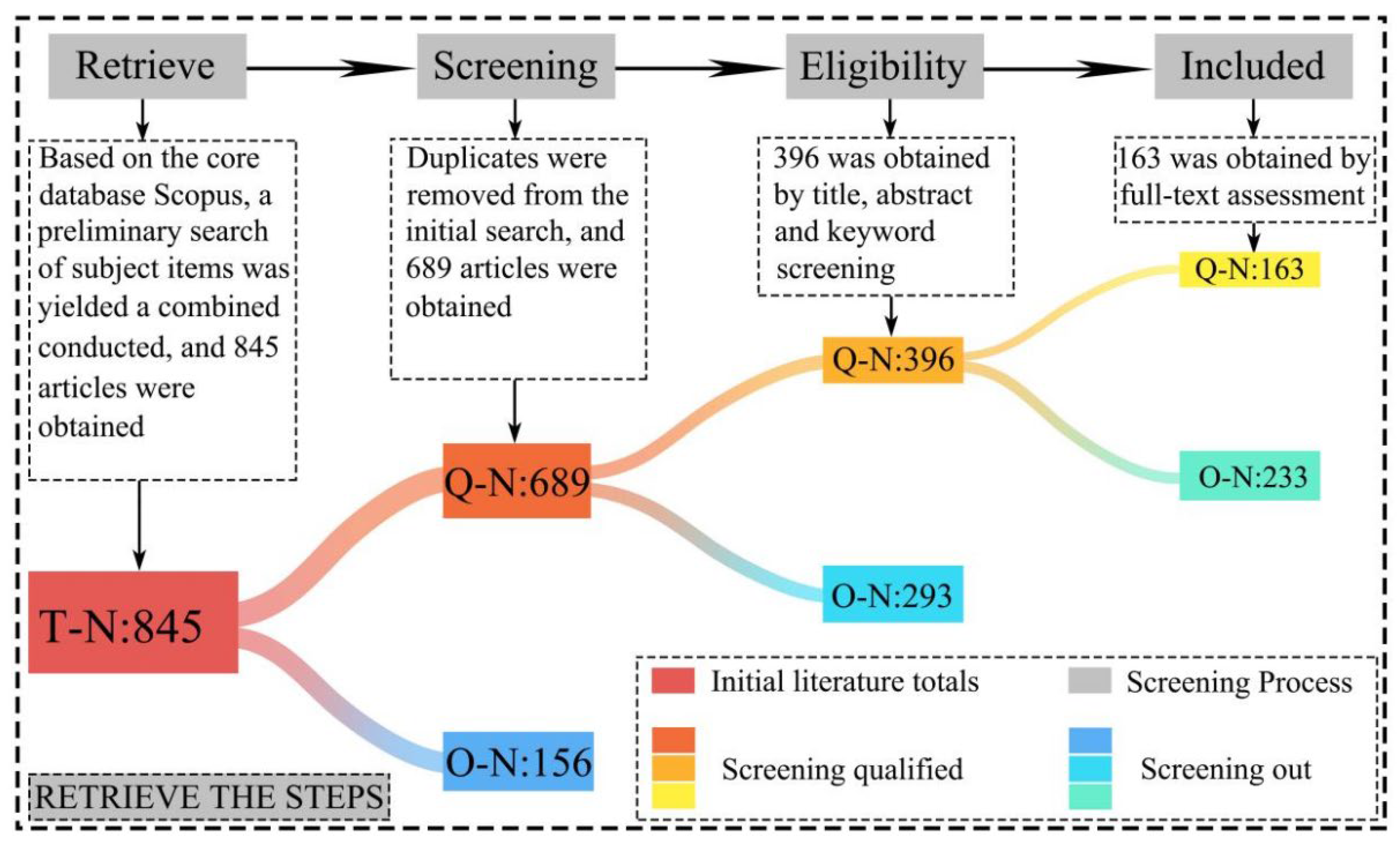
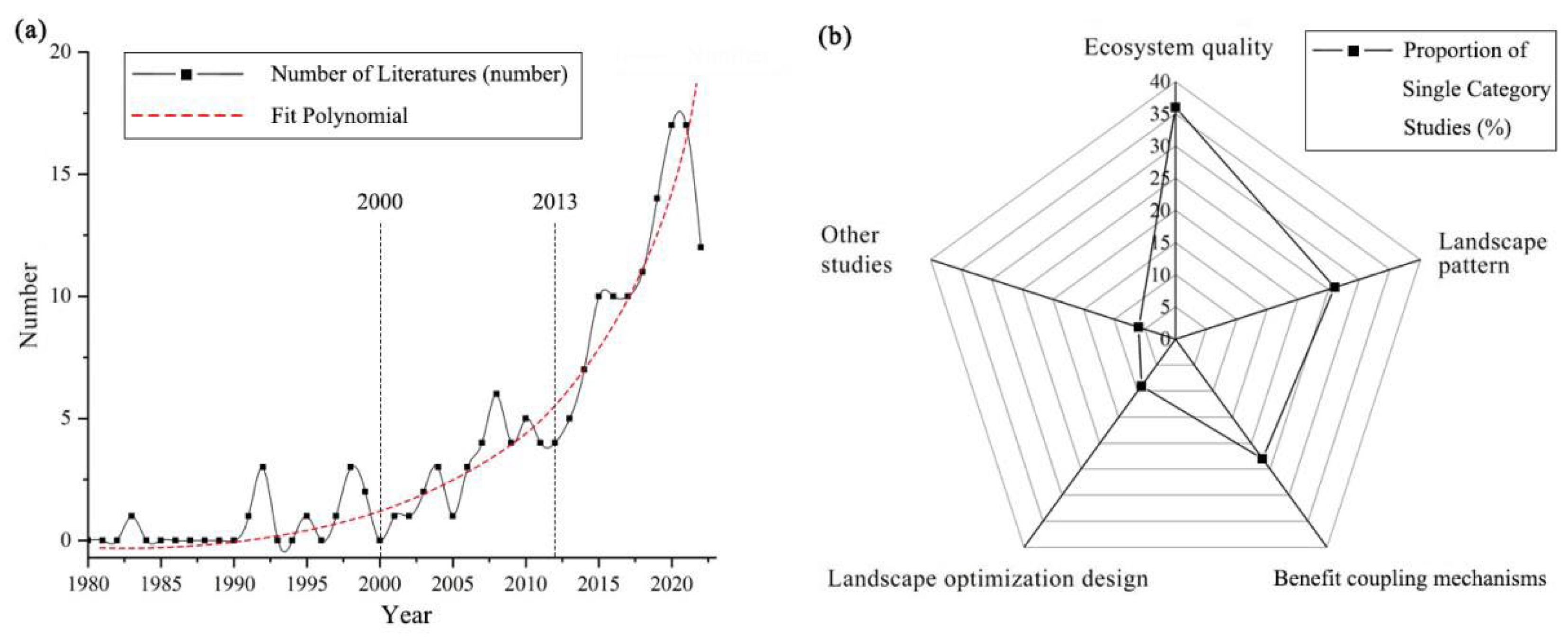
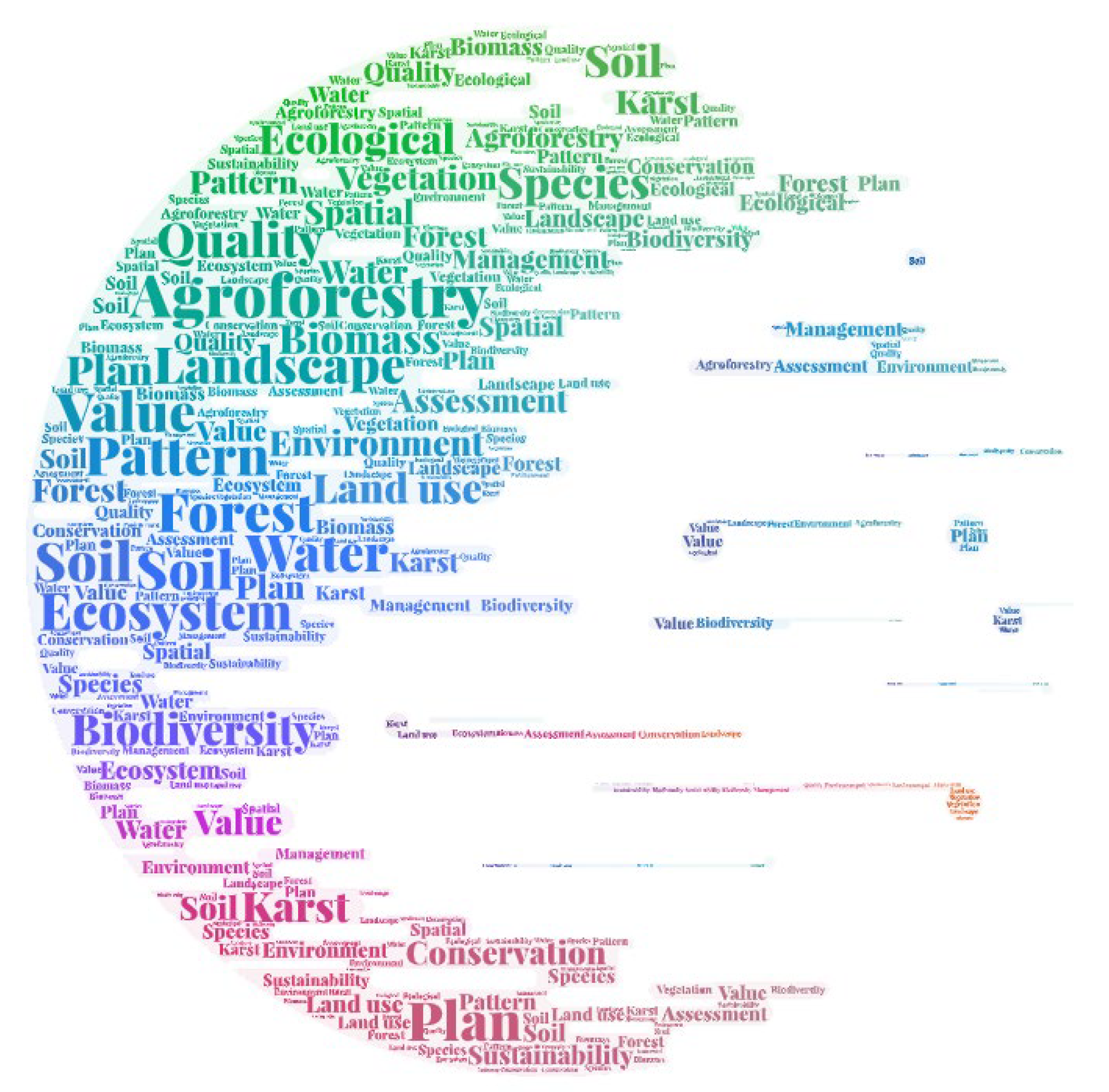
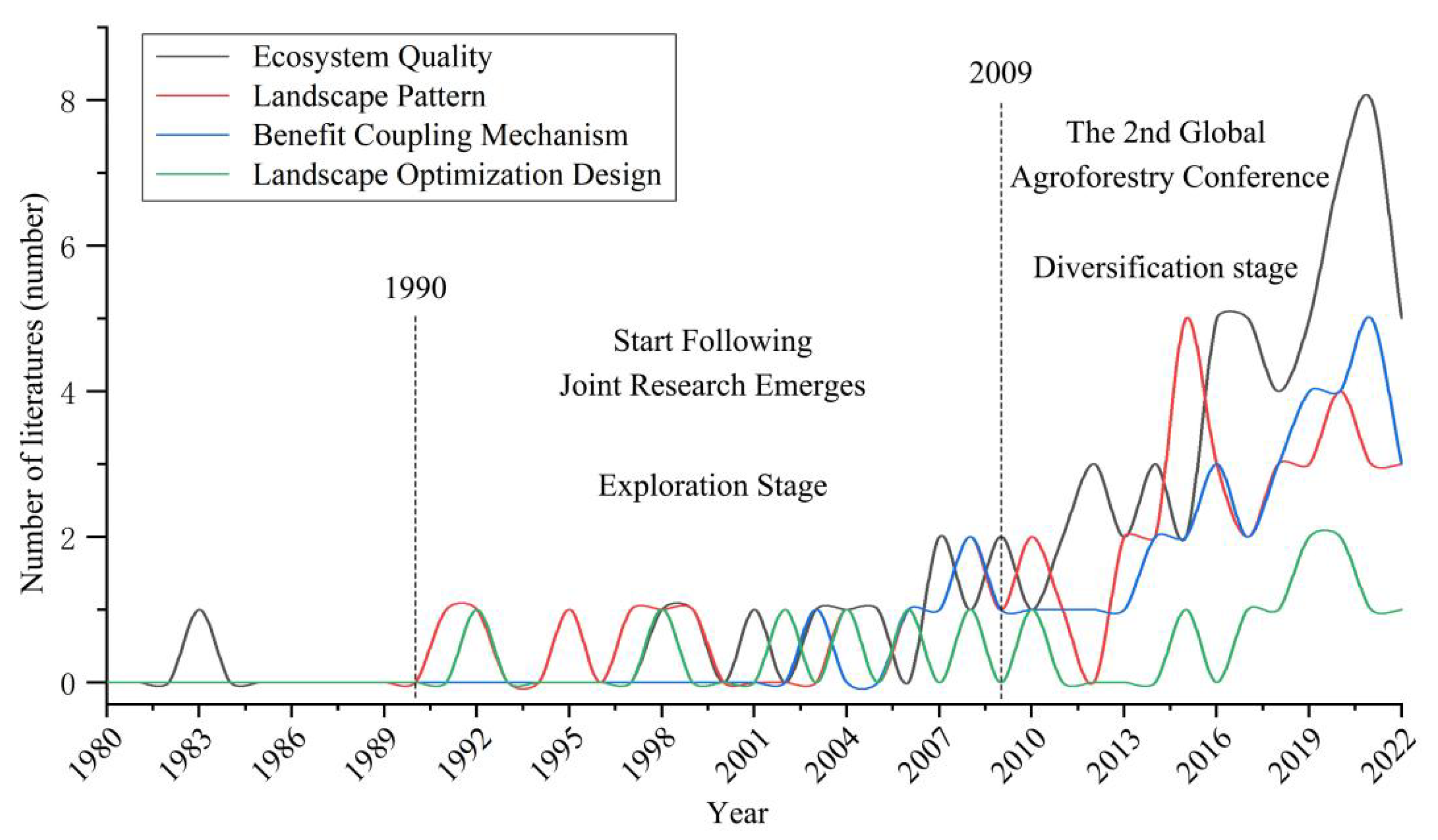
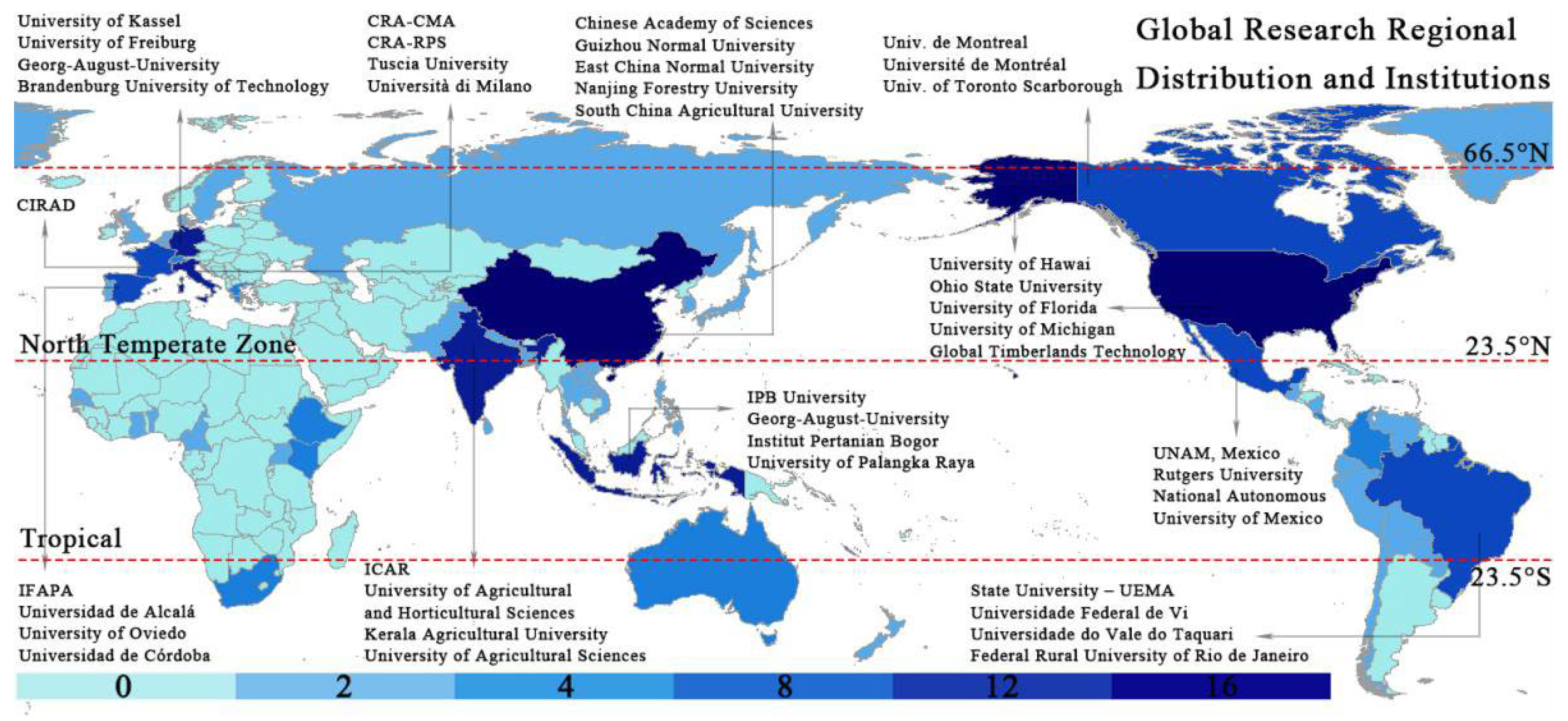

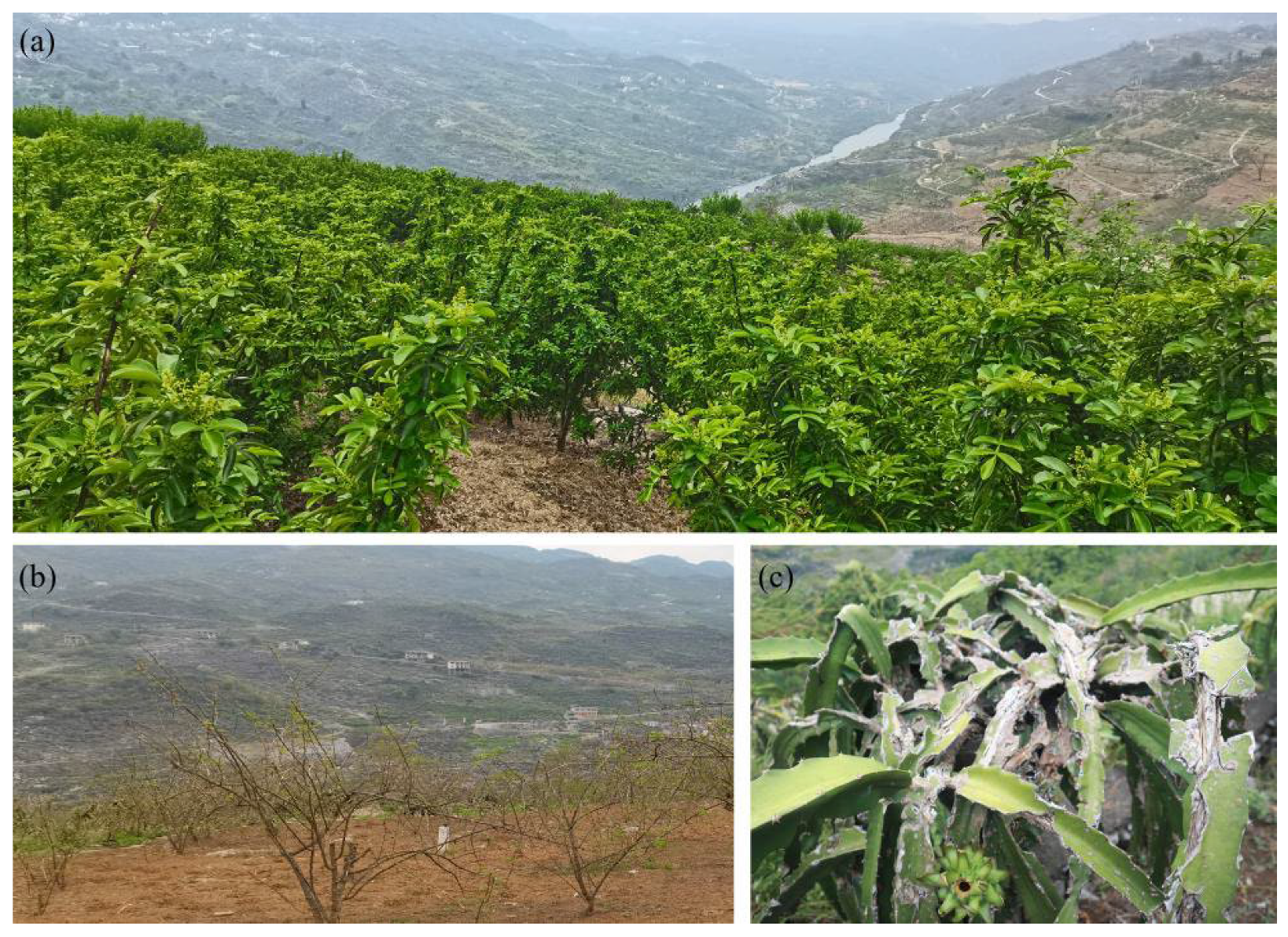

| Year | Journal | Title | Keywords | Focus Point |
|---|---|---|---|---|
| 2017 | Water Resour Manage | Environmental Benefits and Control of Pollution to Surface Water and Groundwater by Agroforestry Systems: A Review [14] | Agroforestry systems, alley cropping, fertilizers, pesticides, control of leachingto groundwater, control of surface runoff pollution | Environmental benefits |
| 2018 | Animal Production Science | Agroforestry for ruminants: A review of trees and shrubs as fodder in silvopastoral temperate and tropical production systems [15] | Agroforestry, biodiversity, ecosystem services, landscape ecology, pest regulation, pollination | Summary of ecosystem services |
| 2022 | Forests | Structure and Stability of Agroforestry Ecosystems: Insights into the Improvement of Service Supply Capacity of Agroforestry Ecosystems under the Karst Rocky Desertification Control [16] | Agroforestry, ecosystem, structure, stability, progress, insights, rocky desertification control | Structural and functional stability |
| 2022 | Science of the Total Environment | A review of agroforestry ecosystem services and its enlightenment on the ecosystem improvement of rocky desertification control [17] | Agroforestry, generating elements, service management, supply capacity, gaps | The influence of service generating factors on supply capacity |
| Database | Retrieval String | Number | Search Date |
|---|---|---|---|
| Scopus | First search string,“ecosystem quality”; second search string, “agroforestry” | 375 | 30 June 2022 |
| First search string,“landscape pattern”; second search string, “agroforestry” | 253 | 30 June 2022 | |
| First search string:“ecological quality”; second search string, “agroforestry” | 217 | 30 June 2022 | |
| Total | ELA | 845 | 30 June 2022 |
| Study Stages | Key Features | Breakthroughs in Stages |
|---|---|---|
| Stage of germination (1983–2000) | Fewer relevant studies in this phase, with a maximum of 3 ELA-related studies in a single year. | 1983 “Agroforestry Ecosystems as Human Environment” was published. In the early 1990s, the U.S. Environmental Protection Agency (U.S.EPA) introduced the Environmental Monitoring and Assessment Program (EMAP). In 1995, Fu BJ studied agroecosystems in loess areas with landscape pattern theory [84]. The preliminary foundation of ELA research was laid. |
| Stage of slow growth (2001–2013) | The number of literature increased during this period, and although there were fluctuations, the overall upward trend was maintained. | 3S technology has developed, models have been developed and applied, and quantitative studies combining multiple factors such as vegetation, topography, and climate have matured [85,86]. In 2000, Wu JG published “Landscape Ecology—Concepts and Theory”, and the MA in 2001 was officially launched, which promoted the research process of ELA [1,87]. |
| Stage of high-speed development (2014–present) | The number of studies grew significantly during this period, especially from 2020 to June 2022, when the total number of studies published reaching 46. | Wu (2013) elucidated the dynamic relationship between human well-being and sustainability of ecosystem services from a landscape ecology perspective [83]. Xie et al. (2015) revised the ecosystem assessment system, made progress in quality assessment and dynamic monitoring, and significantly improved the methodology and theory [88]. |
Disclaimer/Publisher’s Note: The statements, opinions and data contained in all publications are solely those of the individual author(s) and contributor(s) and not of MDPI and/or the editor(s). MDPI and/or the editor(s) disclaim responsibility for any injury to people or property resulting from any ideas, methods, instructions or products referred to in the content. |
© 2022 by the authors. Licensee MDPI, Basel, Switzerland. This article is an open access article distributed under the terms and conditions of the Creative Commons Attribution (CC BY) license (https://creativecommons.org/licenses/by/4.0/).
Share and Cite
Wu, Z.; Xiong, K.; Zhu, D.; Xiao, J. Revelation of Coupled Ecosystem Quality and Landscape Patterns for Agroforestry Ecosystem Services Sustainability Improvement in the Karst Desertification Control. Agriculture 2023, 13, 43. https://doi.org/10.3390/agriculture13010043
Wu Z, Xiong K, Zhu D, Xiao J. Revelation of Coupled Ecosystem Quality and Landscape Patterns for Agroforestry Ecosystem Services Sustainability Improvement in the Karst Desertification Control. Agriculture. 2023; 13(1):43. https://doi.org/10.3390/agriculture13010043
Chicago/Turabian StyleWu, Zhigao, Kangning Xiong, Dayun Zhu, and Jie Xiao. 2023. "Revelation of Coupled Ecosystem Quality and Landscape Patterns for Agroforestry Ecosystem Services Sustainability Improvement in the Karst Desertification Control" Agriculture 13, no. 1: 43. https://doi.org/10.3390/agriculture13010043






